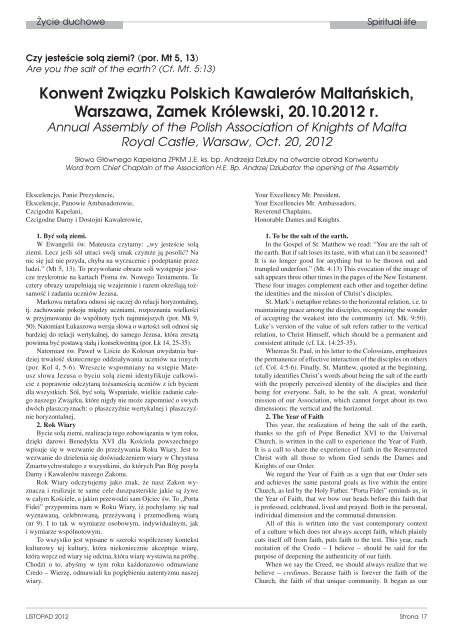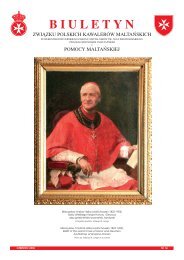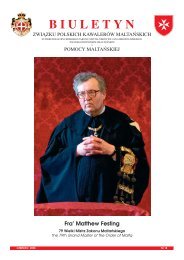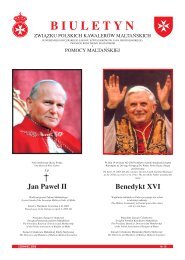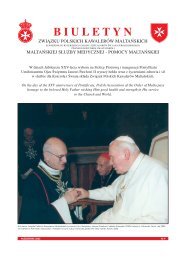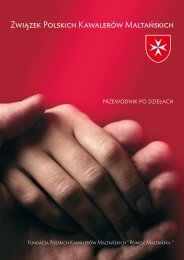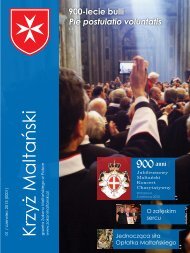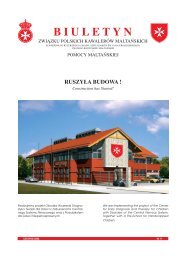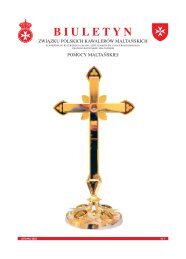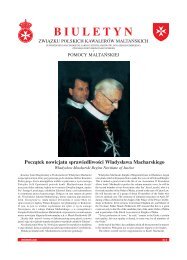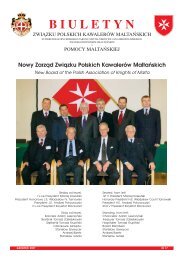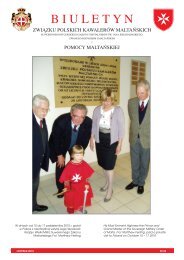B I U L E T Y N - Zakon Maltański Polska
B I U L E T Y N - Zakon Maltański Polska
B I U L E T Y N - Zakon Maltański Polska
You also want an ePaper? Increase the reach of your titles
YUMPU automatically turns print PDFs into web optimized ePapers that Google loves.
Życie duchowe<br />
Spiritual life<br />
Czy jesteście solą ziemi? (por. Mt 5, 13)<br />
Are you the salt of the earth? (Cf. Mt. 5:13)<br />
Konwent Związku Polskich Kawalerów <strong>Maltański</strong>ch,<br />
Warszawa, Zamek Królewski, 20.10.2012 r.<br />
Annual Assembly of the Polish Association of Knights of Malta<br />
Royal Castle, Warsaw, Oct. 20, 2012<br />
Słowo Głównego Kapelana ZPKM J.E. ks. bp. Andrzeja Dziuby na otwarcie obrad Konwentu<br />
Word from Chief Chaplain of the Association H.E. Bp. Andrzej Dziubafor the opening of the Assembly<br />
Ekscelencjo, Panie Prezydencie,<br />
Ekscelencje, Panowie Ambasadorowie,<br />
Czcigodni Kapelani,<br />
Czcigodne Damy i Dostojni Kawalerowie,<br />
1. Być solą ziemi.<br />
W Ewangelii św. Mateusza czytamy: „wy jesteście solą<br />
ziemi. Lecz jeśli sól utraci swój smak czymże ją posolić? Na<br />
nic się już nie przyda, chyba na wyrzucenie i podeptanie przez<br />
ludzi.” (Mt 5, 13). To przywołanie obrazu soli występuje jeszcze<br />
trzykrotnie na kartach Pisma św. Nowego Testamentu. Te<br />
cztery obrazy uzupełniają się wzajemnie i razem określają tożsamość<br />
i zadania uczniów Jezusa.<br />
Markowa metafora odnosi się raczej do relacji horyzontalnej,<br />
tj. zachowanie pokoju między uczniami, rozpoznania wielkości<br />
w przyjmowaniu do wspólnoty tych najmniejszych (por. Mk 9,<br />
50). Natomiast Łukaszowa wersja słowa o wartości soli odnosi się<br />
bardziej do relacji wertykalnej, do samego Jezusa, która zresztą<br />
powinna być postawą stałą i konsekwentną (por. Łk 14, 25-35).<br />
Natomiast św. Paweł w Liście do Kolosan uwydatnia bardziej<br />
trwałość skutecznego oddziaływania uczniów na innych<br />
(por. Kol 4, 5-6). Wreszcie wspomniany na wstępie Mateusz<br />
słowa Jezusa o byciu solą ziemi identyfikuje całkowicie<br />
z poprawnie odczytaną tożsamością uczniów z ich byciem<br />
dla wszystkich. Sól, być solą. Wspaniałe, wielkie zadanie całego<br />
naszego Związku, które nigdy nie może zapomnieć o swych<br />
dwóch płaszczyznach: o płaszczyźnie wertykalnej i płaszczyźnie<br />
horyzontalnej.<br />
2. Rok Wiary<br />
Bycie solą ziemi, realizacja tego zobowiązania w tym roku,<br />
dzięki darowi Benedykta XVI dla Kościoła powszechnego<br />
wpisuje się w wezwanie do przeżywania Roku Wiary. Jest to<br />
wezwanie do dzielenia się doświadczeniem wiary w Chrystusa<br />
Zmartwychwstałego z wszystkimi, do których Pan Bóg posyła<br />
Damy i Kawalerów naszego <strong>Zakon</strong>u.<br />
Rok Wiary odczytujemy jako znak, że nasz <strong>Zakon</strong> wyznacza<br />
i realizuje te same cele duszpasterskie jakie są żywe<br />
w całym Kościele, a jakim przewodzi sam Ojciec św. To „Porta<br />
Fidei” przypomina nam w Roku Wiary, iż pochylamy się nad<br />
wyznawaną, celebrowaną, przeżywaną i przemodloną wiarą<br />
(nr 9). I to tak w wymiarze osobowym, indywidualnym, jak<br />
i wymiarze wspólnotowym.<br />
To wszystko jest wpisane w szeroki współczesny kontekst<br />
kulturowy tej kultury, która niekoniecznie akceptuje wiarę,<br />
która wręcz od wiary się odcina, która wiarę wystawia na próbę.<br />
Chodzi o to, abyśmy w tym roku każdorazowo odmawiane<br />
Credo – Wierzę, odmawiali ku pogłębieniu autentyzmu naszej<br />
wiary.<br />
Your Excellency Mr. President,<br />
Your Excellencies Mr. Ambassadors,<br />
Reverend Chaplains,<br />
Honorable Dames and Knights.<br />
1. To be the salt of the earth.<br />
In the Gospel of St. Matthew we read: “You are the salt of<br />
the earth. But if salt loses its taste, with what can it be seasoned?<br />
It is no longer good for anything but to be thrown out and<br />
trampled underfoot.” (Mt. 4:13) This evocation of the image of<br />
salt appears three other times in the pages of the New Testament.<br />
These four images complement each other and together define<br />
the identities and the mission of Christ’s disciples.<br />
St. Mark’s metaphor relates to the horizontal relation, i.e. to<br />
maintaining peace among the disciples, recognizing the wonder<br />
of accepting the weakest into the community (cf. Mk. 9:50).<br />
Luke’s version of the value of salt refers rather to the vertical<br />
relation, to Christ Himself, which should be a permanent and<br />
consistent attitude (cf. Lk. 14:25-35).<br />
Whereas St. Paul, in his letter to the Colossians, emphasizes<br />
the permanence of effective interaction of the disciples on others<br />
(cf. Col. 4:5-6). Finally, St. Matthew, quoted at the beginning,<br />
totally identifies Christ’s words about being the salt of the earth<br />
with the properly perceived identity of the disciples and their<br />
being for everyone. Salt, to be the salt. A great, wonderful<br />
mission of our Association, which cannot forget about its two<br />
dimensions: the vertical and the horizontal.<br />
2. The Year of Faith<br />
This year, the realization of being the salt of the earth,<br />
thanks to the gift of Pope Benedict XVI to the Universal<br />
Church, is written in the call to experience the Year of Faith.<br />
It is a call to share the experience of faith in the Resurrected<br />
Christ with all those to whom God sends the Dames and<br />
Knights of our Order.<br />
We regard the Year of Faith as a sign that our Order sets<br />
and achieves the same pastoral goals as live within the entire<br />
Church, as led by the Holy Father. “Porta Fidei” reminds us, in<br />
the Year of Faith, that we bow our heads before this faith that<br />
is professed, celebrated, lived and prayed. Both in the personal,<br />
individual dimension and the communal dimension.<br />
All of this is written into the vast contemporary context<br />
of a culture which does not always accept faith, which plainly<br />
cuts itself off from faith, puts faith to the test. This year, each<br />
recitation of the Credo – I believe – should be said for the<br />
purpose of deepening the authenticity of our faith.<br />
When we say the Creed, we should always realize that we<br />
believe – credimus. Because faith is forever the faith of the<br />
Church, the faith of that unique community. It began as our<br />
LISTOPAD 2012 Strona 17


